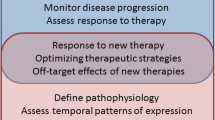Abstract
There is growing interest in the development of methods for imaging cellular and molecular mediators of cardiovascular diseases. Techniques for imaging molecular and cellular alterations have been explored for essentially all noninvasive cardiac imaging modalities. Molecular imaging with contrast-enhanced ultrasound relies on the detection of novel site-targeted microbubble contrast agents. These microbubbles are retained within regions of a specific disease process, thereby allowing phenotypic characterization of tissue. As microbubbles are pure intravascular tracers, the disease processes assessed must be characterized by antigens that are expressed within the vascular compartment. Accordingly, the pathologic states that have been targeted include inflammation, neoplasms, angiogenesis, and thrombus formation, all of which are mediated in part by molecular events within the vascular space. This review describes (1) different strategies that have been used to target microbubbles to regions of disease, (2) the unique challenges for imaging targeted ultrasound contrast agents, and (3) some of the early experience imaging molecular events in animal models of disease.
Similar content being viewed by others
References
Lindner JR, Coggins MP, Kaul S, et al. Microbubble persistence in the microcirculation during ischemia-reperfusion and inflammation: integrin- and complement-mediated adherence to activated leukocytes. Circulation 2000;101:668–75.
Klibanov AL. Targeted delivery of gas-filled microspheres, contrast agents for ultrasound imaging. Adv Drug Deliv Rev 1999;37: 139–57.
Dayton PA, Pearson D, Clark J,et al. Ultrasonic enhancement of αvβ3-expressing cells with targeted contrast agents. Proc IEEE Ultrasonics Symposium; October 5–8, 2003.
Lindner JR, Song J, Xu F, et al. Noninvasive ultrasound imaging of inflammation using microbubbles targeted to activated leukocytes. Circulation 2000;102:2745–50.
Springer TA. Adhesion receptors of the immune system. Nature 1990;346:425–34.
Ley K. Molecular mechanisms of leukocyte recruitment in the inflammatory process. Cardiovasc Res 1996;32:733–42.
Jung U, Norman KE, Scharffetter-Kochanek K, Beaudet AL, Ley K. Transit time of leukocytes rolling through venules controls cytokine-induced inflammatory cell recruitment in vivo. J Clin Invest 1998;102:1526–33.
Lindner JR, Dayton PA, Coggins MP, et al. Non-invasive imaging of inflammation by ultrasound detection of phagocytosed microbubbles. Circulation 2000;102:531–8.
Dayton PA, Chomas JE, Lum A, et al. Optical and acoustical dynamics of microbubble contrast agents inside neutrophils. Biophys J 2001;80:1547–56.
Christiansen JP, Leong-Poi H, Xu F, et al. Non-invasive imaging of myocardial reperfusion injury using leukocyte-targeted contrast echocardiography. Circulation 2002;105:1764–7.
Lindner JR, Song J, Christiansen J, et al. Ultrasound assessment of inflammation and renal tissue injury with microbubbles targeted to P-selectin. Circulation 2001;104:2107–12.
Villanueva FS, Jankowski RJ, Klibanov S, et al.Microbubbles targeted to intercellular adhesion molecule-I bind to activated coronary endothelial cells. Circulation 1998;98:1–5.
Davis C, Christiansen JP, Klibanov AL, et al.Microbubbles targeted to endothelial VCAM-1 adhere to atherosclerotic plaques at physiologic shear rates [abstract]. Circulation 2003;108(Suppl):IV-624.
Nakashima Y, Raines EW, Plump AS, Breslow JL, Ross R. Upregulation of VCAM-1 and ICAM-1 at atherosclerosis-prone sites on the endothelium in the ApoE-deficient mouse. Arterioscler Thromb Vasc Biol 1998;18:842–51.
Alkan-Onyuksel H, Demos S, Lanza G, et al.Development of inherently echogenic liposomes as an ultrasonic contrast agent. J Pharm Sci 1996;85:486–90.
Demos SM, Alkan-Onyuksel H, Kane BJ, et al.In vivo targeting of acoustically reflective liposomes for intravascular and transvalvular ultrasonic enhancement. J Am Coll Cardiol 1999;33:867–75.
Weller GER, Lu E, Csikari MM, et al.Ultrasound imaging of acute cardiac transplant rejection with microbubbles targeted to intercellular adhesion molecule-1. Circulation 2003;108:218–24.
Folkman J, Watson K, Ingber D. Induction of angiogenesis during the transition from hyperplasia to neoplasia. Nature 1989;339:58–61.
Moulton KS, Vakili K, Zurakowski D, et al.Inhibition of plaque neovascularization reduces macrophage accumulation and progression of advanced atherosclerosis. Proc Natl Acad Sci U S A 2003;100:4736–41.
Leong-Poi H, Christiansen J, Klibanov AL, Kaul S, Lindner JR. Non-invasive assessment of angiogenesis by ultrasound and microbubbles targeted to αv-integrins. Circulation 2003;107:455–60.
Ellegala DB, Leong-Poi H, Carpenter JE, et al.Imaging tumor angiogenesis with contrast ultrasound and microbubbles targeted to αvβ3. Circulation 2003;108:336–41.
Francis CW, Onundarson PT, Carstensen EL, Blinc A, Meltzer RS. Enhancement of fibrinolysis in vitro by ultrasound. J Clin Invest 1992;90:2063–8.
Tachibana K, Tachibana S. Albumin microbubble echo-contrast material as an enhancer for ultrasound accelerated thrombolysis. Circulation 1995;92:1148–50.
Unger EC, McCreery TP, Sweitzer RH, Shen D, Wu G. In vitro studies of a new thrombus-specific ultrasound contrast agent. Am J Cardiol 1998;81:58G-61G.
Lanza GM, Wallace KD, Scott MJ, et al.A novel site-targeted ultrasonic contrast agent with broad biomedical application. Circulation 1997;95:3334–40.
Shohet RV, Chen S, Zhou Y, et al.Echocardiographic destruction of albumin microbubbles directs gene delivery to the myocardium. Circulation 2000;101:2554–6.
Tamiyama Y, Tachibana K, Hiraoka K, et al.Local delivery of plasmid DNA into a rat carotid artery using ultrasound. Circulation 2002;105:1233–9.
Christiansen JP, French BA, Klibanov AL, Kaul S, Lindner JR. Targeted tissue transfection with ultrasound destruction of plasmid- bearing cationic microbubbles. Ultrasound Med Biol 2003;29: 1759–67.
Author information
Authors and Affiliations
Corresponding author
Additional information
Supported by grants from the National Institutes of Health (R01-DK063508), Bethesda, Md, and the American Heart Association Mid-Atlantic Affiliate, Baltimore, Md.
Rights and permissions
About this article
Cite this article
Lindner, J.R. Molecular imaging with contrast ultrasound and targeted microbubbles. J Nucl Cardiol 11, 215–221 (2004). https://doi.org/10.1016/j.nuclcard.2004.01.003
Published:
Issue Date:
DOI: https://doi.org/10.1016/j.nuclcard.2004.01.003




